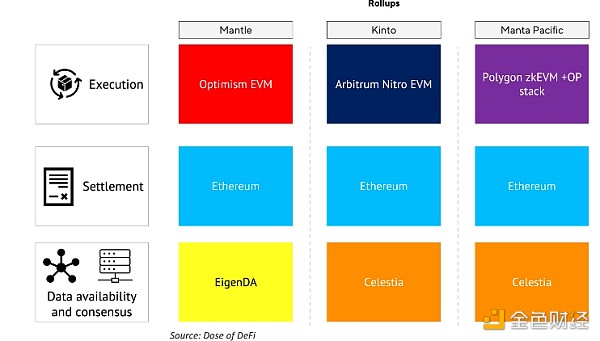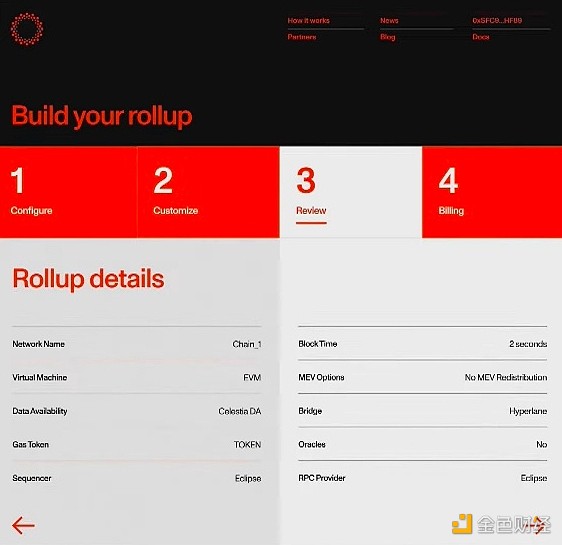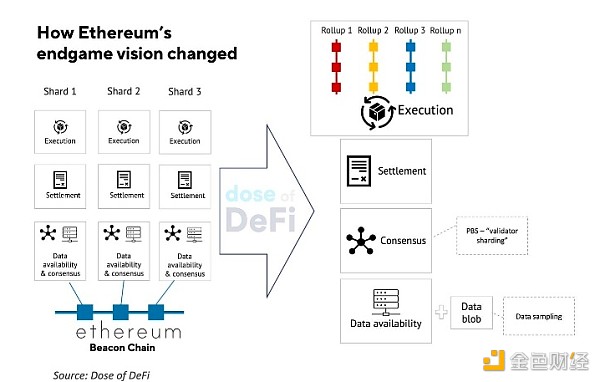Author: Chris Powers, founder of Does of DeFi; Translator: Golden Finance xiaozou
1. The era of monomers?
Solana has become very popular recently, and rightly so. It has weathered the dark days of the Alameda crisis, ushered in strong price action, stopped experiencing frequent outages, and even managed to handle what could be described as the busiest airdrop claims ever, while maintaining incredibly low fees. From the perspective of attracting new users, Solana is a good choice: Ethereum L2 charges up to $1 per transaction (we really don't recommend starting with BSC or Tron).
Another big advantage of Solana is that its single global state reflects all market signals at once, without the need for arbitrage and bridging between rollups or shards. It is as if trading on all global exchanges is 24 hours a day, regardless of geographical location or time zone, and all events are immediately reflected in price changes on all exchanges.
These are the greatest benefits of a monolithic blockchain, but this design choice still has flaws. The most notable one is that the hardware requirements are very high, so Solana’s validator set is becoming increasingly centralized. This is because Solana uniformly handles all three layers of the blockchain: execution, consensus, and data availability.
Modular architectures as opposed to this design choice—particularly outsourcing the data availability layer—are becoming increasingly popular. The modular approach reduces transaction costs while maintaining low hardware requirements (although MEV poses a threat to this). The modular design also allows for more targeted chains and hardware for specific applications, dYdX being the best example.
Celestia is at the forefront of the modular movement and is a chain optimized for rollup data efficiency. Ethereum, on the other hand, has implemented a modular approach bit by bit, building aircraft as they fly. We believe that as competition intensifies for the data availability layer (and the rest of the modular stack), rollups are key to enabling scaling and lowering transaction costs.
2. Scaling and Data Barriers
Data availability issues were first discovered during early blockchain scaling competitions. The focus is on minimizing the amount of data that needs to be stored in order to maximize the number of network nodes. The same goes for the Bitcoin network’s block size battle. Data availability refers to a blockchain’s ability to make its data accessible to all network participants. The key breakthrough to overcome this problem is the introduction of Data Availability Sampling (DAS), as Bridget Harris described:
“With DAS, light nodes can participate in random sampling of block data. Confirmation data is available without having to download each block in its entirety. Once multiple rounds of sampling are complete—and a certain confidence threshold is reached that confirmation data is available—the rest of the transaction process can proceed safely. In this way, the blockchain can scale its block size while maintaining simple data availability verification. And, there are significant cost savings: these emerging layers can reduce data availability costs by up to 99%."
Celestia, Avail, NearDA, and EigenDA are The most important DA (data availability) item. They do not need to verify transactions, only check that blocks were added via consensus and that new blocks are available on the network. They rely on third-party orderers to perform validated transactions. Celestia launches in October 2023, Avail and EigenDA will be on mainnet in the coming months, and Near recently announced its own DA solution. Let's take a look at what makes each of them unique:
Celestia chose The fastest way to market is through fraud proof (an approach also used by optimistic rollup). The corresponding trade-off is that in the current configuration, Celestia cannot provide support for ZK rollup. The Celestia team claims that approximately 70% of new Arbitrum Orbit chains are using Celestia for data availability.
Avail (formerly Polygon Avail) serves as an independent blockchain from Polygon with a fast and secure data and consensus layer, launching rollups for developers (whether it is a ZK rollup or optimistic rollup) to help.
EigenDA is probably the most aligned with Ethereum because it is a DA module, not a blockchain. In addition, ETH re-staking in EigenLayer will be available for rollup security through EigenDA. The disadvantage is that no data sampling or proof of data availability is used.
NearDA can save rollup data availability costs by storing data on Near's shard chain. NearDA leverages an important part of the Near consensus mechanism, which parallelizes the network into multiple shards.
3. Start massive rollup
Then let’s look at the rollup itself. In rollups built on top of these DA vendors, there are a number of tools that make starting the rollup easier:
By leveraging Celestia’s modular data availability, Manta Pacific costs significantly less than a standalone L2 solution and has already saved $1 million in Ethereum gas fees. Manta also uses custom opcodes to verify ZK (zero-knowledge) technology, which allows them to have protocol privacy and local randomness at a very low cost.
The Mantle network is built on a modular architecture that integrates the optimistic rollup protocol with EigenDA’s data availability solution. This convergence allows the Mantle network to inherit the security of Ethereum while also providing more affordable and accessible data availability.
kinto is a KYC chain, and every user and developer must complete the passport KYC real-name authentication process before conducting transactions on the network. It uses Celestia to reduce costs.
In a truly modular approach, each layer of modules is selected based on specific needs. The following are various combinations:
 Like Eclipse The RaaS (rollup-as-a-service: rollup as a service) project makes it easier to start rollup, and developers can choose which technology to use for each of the three modules.
Like Eclipse The RaaS (rollup-as-a-service: rollup as a service) project makes it easier to start rollup, and developers can choose which technology to use for each of the three modules.
Similarly, Conduit lets you deploy a rollup in 15 minutes, powered by Optimism, Arbitrum Orbit and Celestia. There are monthly hosting infrastructure fees to Conduit and separate data availability fees to the DA provider.

Modularization brings The vast number of possible combinations is certainly an important step forward. Is this similar to how difficult it was to create a website in the early days compared to the ease of use and customization that Squarespace has today?
4. Weighing the pros and cons
Although DA projects are growing, many people have reservations about outsourcing DA. Vitalik made it clear: “Your data layer must be your security layer.” Dankrad Feist, another member of the Ethereum Foundation, also agreed: “If you don’t use Ethereum for data availability, then it’s not (Ethereum rollup) , that is, it is not Ethereum L2."
We agree with this view. But a rollup with outsourced data availability will be less secure than a rollup using the same chain for data and consensus (which should actually be called "validiums"), although it will be secure enough for some applications. Short-term projects using this type of rollup will appear and disappear quickly, and at best they will become a good experimental testing ground. However, for long-term holding of financial assets, L1 like Ethereum or rollup using the same chain for data and consensus will still be the lowest risk network.
5. Ethereum is moving towards modularization
Although skeptical about the availability of outsourced data, Ethereum is moving further and further in the direction of modular architecture. The early vision of sharded scaling was abandoned in favor of a modular path.

The three major updates needed to realize this vision are rollup, proposer-builder separation ("rather than the block proposer generating a 'revenue maximizing' block themselves, the task is delegated to outside parties "Builders Market") and data sampling. The latter is a way for light nodes to verify that a block has been published by simply downloading some randomly selected pieces of data. This is more challenging on a technical level than the other two and will take two to three years to deliver.
Important: EIP-4844 is the first step in improving the Ethereum data availability layer before data sampling begins. As mentioned before, enhancing Ethereum performance is like building an airplane while flying; when the Ethereum Foundation recognized the need for rollups, the team chose to expand blocks using blobs (dedicated space tailored for rollup data) . Blobs are expected to reduce rollup transaction costs by 10 times. EIP-4844 is scheduled to go live with the Dencun upgrade in March or April. This is an interim solution to keep Ethereum competitive for two to three years, while a long-term solution will support proof-of-validity on the mainnet itself, which will reduce the cost of rollups by orders of magnitude.
While Solana may vehemently defend its monolithic architecture philosophy (and may be proven correct in many use cases), the industry appears to be converging toward modularity. In the case of Ethereum, only a modular architecture can achieve such a future:
* Thanks to rollup, transactions become cheaper for millions of users (scalability);< /p>
* The network is protected from threats such as censorship and 51% attacks (security);
* Ordinary PCs and even mobile devices can run nodes to verify transactions (decentralization).
Someone may ask, does Ethereum’s modular architecture solve the originally unsolvable blockchain trilemma? Technically, Ethereum does not solve this dilemma because it is no longer a monolithic network, but as a modular network, it can be said that it provides a solution.
Among the three aspects of the future mentioned above, we believe that decentralization is the most important part of solving the trilemma. Innovation ultimately reduces transaction costs; prioritizing decentralization (especially geographically) is the only way to ensure long-term network security. Ethereum has the largest set of distributed validators, with more than 800,000 validators, making it the leader of decentralization. At the same time, with a modular approach, it can adapt to new design innovations by launching custom rollups. Celestia and other projects certainly feel the same way. The question that remains is whether Ethereum can move quickly in this modular direction to keep up with competition, whose competitors are being built from the ground up, unlike Ethereum, which is fixing planes as they fly.
 Cheng Yuan
Cheng Yuan
 Cheng Yuan
Cheng Yuan Xu Lin
Xu Lin JinseFinance
JinseFinance JinseFinance
JinseFinance JinseFinance
JinseFinance Bernice
Bernice Coinlive
Coinlive  Nell
Nell Cointelegraph
Cointelegraph Cointelegraph
Cointelegraph